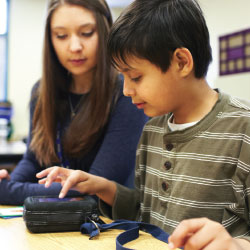Bright Ideas: Harness Technology That Gives Kids a Voice
A new special education teacher, Alyssa Anderson '11 walked into her classroom at Lakeview Elementary in Kirkland, Washington, in January 2012.
Not only did she meet her students for the first time — 11 children with a very wide variety of “high-needs” learning challenges, including several with autism spectrum disorders — but she also found a very wide variety of new technology. Five or six students use iPads with special communication software, which, in some cases, are provided by the Lake Washington School District.
“A lot of our kids are nonverbal or partially verbal, so their communication skills are more of a challenge than a typically developing child,” she says. “It's fascinating to see them using the devices that they use to speak every day.”

![]() View more photos
View more photos
“I don't like to define my kids by their disabilities,” says special education teacher Alyssa Anderson (left). “They each have their own strengths and challenges, and it's cool to see how each kid functions differently.”
One student exclusively uses an iPod Touch to communicate.
“He says ‘hi' with it, he asks questions, and he spells really well,” Anderson says. Her classroom is equipped with computers and an ActivBoard, a large blackboard that is an interactive touch screen. She spent a few days teaching herself how to use the board, and quickly began to deploy it in the large group setting, where the children learn how to take turns and wait while someone else uses the board.
“My kids love technology. They use it every day on their own. So when they get to do it in a group setting, it's fun for them, too,” she says. She's already thinking ahead to how to better use the board, planning to scan some of her paper curriculum and convert it into digital, interactive lessons.
Her adjustment has involved people as well as technology, of course. She's also quickly developed relationships with the para educators in her classroom, staff who help small groups or individual children. She's built her support network with the learning specialist next door, other teachers, her principal, the other specialists who assist her students in learning (such as occupational therapists and speech language pathologists) — not to mention getting to know students' parents.
The field of special education requires teachers to build teams of supportive adults around their students, says Debby Hudson, SPU assistant professor and chair of special education. So Hudson trains her students to build these teams right from the start. “I always recommend new teachers introduce themselves to all the general education teachers, school counselors, principals,” she
says. “The more you collaborate, the more students will benefit.”
Anderson highlights the support of her district as integral to her success.
Part of this support is adequate funding, which allows her to advocate for — and receive — the learning resources her students need. When the district-provided speakers on one of her students' iPods broke, she says, “All I had to do was email someone, and the order was put in for new speakers the same day.”
But it's not just money. “The district is very inclusive; it's very supportive. I can reach out to anybody I need help from,” she says.
A supportive team, good training, and a growing tech-savvy awareness of how her students learn — all these factors are helping to ensure that, as a new teacher, Anderson will continue to learn and grow.
Create 180-Degree Change With Tiny Steps
Harness Technology That Gives Kids a Voice
Advocate for Students in and out of School
